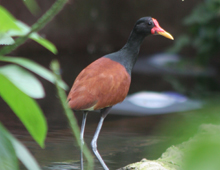Description: Wattled jacana juveniles are dark brown above with white or buffy underparts and a white stripe above the eyes. They also have a black stripe behind the eyes. As they mature, they darken. The presence of any white plumage indicates that it is a young bird. Adults are black and brown with yellow markings on the wings. The forehead is a bright red and red wattles hang down on either side of the yellow bill. Legs and toes are very long.
Size: Females can grow to 23 inches (58 cm) in length and nine ounces (255 gr) in weight. Males are much smaller, growing to around 15 inches (38 cm) in length and 4.8 ounces (136 gr) in weight.
Behavior: They can be found in flocks or communities. Predation is the major mortality factor for the young chicks. Adults will perform distraction displays to take the attention of predators off of the young. Chicks will also dive underwater with only their beak protruding in order to hide from predators, a behavior that is not commonly seen. Jacanas are able to walk on the vegetation that floats on the water due to their long legs and elongated toes that evenly distributes their weight. They are not very good fliers, but are excellent swimmers and divers.
Diet: Wattled jacanas eat insects and invertebrates in floating vegetation and on the water surface.
Communication: A range of noisy, rattling calls can be produced. Males have a complex range of calls to signal danger to their offspring. When they hear these sounds, chicks move closer to the male.
Reproduction: Breeding is polyandrous, which means that one female will mate with several males in the male’s territory. Typically four eggs, glossy brown and covered with speckles, are laid per clutch in a nest built by the male. The male then incubates the eggs and cares for the young. Once a female has laid eggs, she will fight other females to keep them from destroying her eggs and laying their own. Eggs are incubated for 20-26 days. The chicks are very precocious and learn to feed themselves very soon after hatching. Nests are built on partially submerged plants. If the nest begins to sink, or if something else is endangering the eggs, the male will pick up the eggs and carry them under his wings to a new nesting site.
Habitat/range: Wattled jacanas are found in freshwater wetlands from western Panama and Trinidad; south through most of South America east of the Andes.
Status: Categorized as Least Concern on the IUCN Red List.



